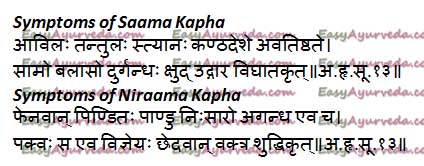Kapha With Ama – Sama, Nirama Kapha – Treatment Principle
Article by Dr Raghuram Y.S. MD (Ay) & Dr Manasa, B.A.M.S
Ama is the product of altered digestion and metabolism. When Ama is associated with Kapha is called Sama kapha. When Kapha is not associated with Ama, it is called Nirama Kapha.
Related Reading – Ama, meaning and definition
Symptoms of Saama and Niraama Kapha
When vitiated, kapha can individually cause wide array of diseases. These diseases will be called as kaphaja diseases.
Kapha associated with ama is totally different condition in comparison to kaphaja diseases since these conditions are associated with toxins derived from improper digestion of food.

Table of Contents
Symptoms of Saama Kapha
Aavila – kapha associated with ama is dirty in appearance
Tantula – string or thread like structures are seen in kapha
Styaana – kapha associated with ama is thick in appearance
Kantha Deshe Avatishtate – gets adhered to the throat, becomes difficult to expel the phlegm stuck within the throat
Durgandha – it acquires foul smell
Kshud vighaatakrit – reduces appetite
Udgaara vighaatakrit – obstructs belching, though there is urge for belching the ama associated with immature food juices doesn’t allow its manifestation
Symptoms of Niraama Kapha
Phenavaan – kapha is frothy in nature
Pindita – kapha appears like a lump being accumulated in the form of thick and condensed mass
Pandu – kapha appears pale in color
Nisaara – semi-solid and tends to flow
Agandha – devoid of any type of odor
Chedavaan – easily gets separated
Vaktra Shuddhikrit – it keeps the throat clear i.e. it doesn’t stick to the throat
Saama Kapha treatment
Treatment principles of Saama Kapha
The main strategy in treating the pathological condition of kapha associated with ama lay in separating the vicious combination of kapha and ama.
Therapeutic emesis is the main treatment of choice to expel morbid kapha. Still, in the condition of kapha associated with ama, vomiting therapy should not be directly given as first choice.
In saama kapha conditions, the kapha associated with endo-toxins have adhered to the walls of the tissues and channels of the body owing to the sticky nature of ama as well as kapha since both share similar properties. In such condition if therapeutic emesis is administrated, it cannot expel the kapha from the body since it is not easy to expel the doshas which are sticking to the body components.
If emesis is forcibly administered, the therapy will try to forcibly pull this adhered kapha from the tissues and channels of the body. While doing so, the vomiting therapy will cause damage to the structures and components of the body instead of helping in the recovery process, i.e. emesis doesn’t work therapeutically. This will lead to many complications including the death of the patient.
Ama Pachana – Initially ama digestive medicines should be administered in treating the kapha associated with ama. The medicines used for pachana or ama digestive treatment are pungent and bitter in taste; possess hot and intense qualities and potency, and pungent post-digestion effect. These properties of pachana would help in digesting and liquefying ama and eventually will separate it from the kapha association. The medicines on the other hand would detach and separate the ama from the walls of tissues and channels and thus prepare them to be expelled from the body.
Agni deepana – The digestive fire should be corrected and brought to normal terms while treating these conditions. The herbs and medicines which kindle the metabolic fire should be administered. As an effect of these medicines the digestive fire will gain strength. It will regain the capacity to digest the food properly. When the food gets digested properly by the digestive fire, ama is not formed in future.
Snehana, Swedana and Shodhana – Oleation therapy should be administered following the separation of ama with the help of ama destroying and fire kindling treatments as mentioned above. For oleation, the person should be administered with medicated ghee for oral consumption. Following oleation, sweat inducing treatments should be administered. Oleation and sweating together will help in liquefying and mobilizing the morbid kapha towards stomach. From the stomach, the kapha should be eliminated by the administration of therapeutic emesis.
Importance
Need for knowing Saama and Niraama Kapha conditions
It is very essential for a physician to know about the saama and niraama kapha. Vitiated kapha and saama-niraama kapha, both are morbid stages but will differ in terms of pathological presentation and treatment. The knowledge of these different pathological state of kapha will help the physician to deferentially diagnose vitiated kapha conditions from saama kapha conditions and also to treat them skillfully.
Click to Consult Dr Raghuram Y.S. MD (Ayu) – Email / Skype








